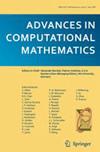An iterative projection method for unsteady Navier–Stokes equations with high Reynolds numbers
Abstract
A new iterative projection method is proposed to solve the unsteady Navier–Stokes equations with high Reynolds numbers. The convectional projection method attempts to project the intermediate velocity to the divergence-free space only once per time step. However, such a velocity is not genuinely divergence-free in general practice, which can yield large errors when the Reynolds number is high. The new method has several important features: the BDF2 time discretization, the skew-symmetric convection in a semi-implicit form, two modulating parameters, and the iterative projections in each time step. A major difficulty in the proof of iteration convergence is the nonlinear convection. We solve this problem by first analyzing the non-convective scheme with a focus on the spectral properties of the iterative matrix and then employing a delicate perturbation analysis for the convective scheme. The work achieves the weakly divergence-free velocity (strongly divergence-free for divergence-free finite element spaces) and the rigorous stability and error analysis when the iterations converge The three-dimensional numerical tests confirm that this new method can effectively treat high Reynolds numbers with only a few iterations per time, where the convectional projection method and the iterative projection method with the explicit convection would fail.

 求助内容:
求助内容: 应助结果提醒方式:
应助结果提醒方式:


